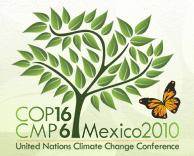Cancun Agreement: US delinquent again!
Monday, December 20th, 2010For United Nations credibility, Cancun had to be better than the Copenhagen shemozzle. Remember when US President Obama’s last minute token promise failed because he hadn’t secured a US Congress mandate.
A memorandum of understanding between the ‘have’ nations and the ‘have not’ nations seems to be a follow-the leader approach to dealing with human-caused climate change – aka ‘pollution’ rebranded. Problem is the responsible leader, the United States is AWOL, delusional that its 20th Century economics can restore its capital prowess in our 21st Century society.
Assuming global warming is real and being caused by human carbon emissions, the overarching aim of the United Nations is to reduce carbon emissions and so minimise global warming and its consequential problems of sea-level rise, mass extinctions and associated climate catastrophes – droughts, floods, heatwaves, massive storms and exponential human misery.
Toward this ideal, COP16 has been the 16th annual Conference of the Parties of the United Nations Framework Convention on Climate Change (COP) and the 6th Conference of the Parties serving as the meeting of the Parties to the Kyoto Protocol (CMP). This year COP16 was hosted in Cancun, Mexico.
So what was the outcome of the conference this time around?
Well, according a summary by The Climate Institute the delegate at COP16 broadly accepted the ‘Cancun Agreement‘ on 14th December 2010. Three important areas of achievement should be noted:
- Anchoring of national mitigation commitments: formal recognition and ‘anchoring’ of existing pollution targets and commitments from all major polluting countries, covering around 80 per cent of global emissions. This is the first time pollution commitments from US, China and all other major economies (both developed and developing) have been captured in a formal UN agreement.
- New ‘Green Climate Fund’: agreement to establish a new fund to help mobilise US$100 billion a year by 2020 to support low pollution economic development; protecting tropical forests and helping the world’s most vulnerable people build resilience to change impacts. However, there was no decision on how to raise the public and private money for this fund.
- Improved transparency: measures to improve transparency and verification of domestic efforts to reduce pollution, including a process for international review of countries’ actions by technical experts.
.
According to Greenpeace, “the talks did not deliver a global climate deal but have placed the building blocks for that strong deal to be created.” There are acknowledgements of the gap between commitments on emissions cuts and scientific evidence, the establishment of a climate fund and an agreement on REDD [United Nations Collaborative Programme on Reducing Emissions from Deforestation and Forest Degradation in Developing Countries].
However, we are still missing the actual commitments on lower emissions, a way to deliver that climate fund and some critical parts of the REDD agreement to make it a strong one. Now we must continue to demand our leaders redouble their efforts to drive change at home.
So in other words, nations are gradually coming around to the climate change problem, but still a bit slow working out what to do. They’re getting there.
There are positive signs of progress, and moreso than the token promises by the United States like at Copenhagen. For instance, there is at least now general agreement that greater pollution reduction effort is required. There are sources of financing by the World Bank to make this happen. There are now common accounting rules, and a legal framework.
Tangible promises have also been committed by Mexico, the host nation of this year’s conference, including a promise to reduce 51 million tons of CO₂ in 2012, securing a US$500 million loan with the World Bank to finance technological assistance and increase scientific knowledge in relation with current sources of emissions and carbon sinks. Mexico has also promised to ensure that in 2012, 26% of the electricity produced will come from renewable sources. Mexico will also receive US$15 million from the Norwegian government to reduce emissions through soil conservation and reforestation.
While the worst polluter and most conspicuous carbon consumer, the United States, has been AWOL and navel-gazing; this time China has promised to cut 45% of its greenhouse gases by 2020.
However, the conference has not been without its criticism. The editor of the Sydney Morning Herald makes the following observations:
“There are no binding targets for reducing greenhouse gas emissions, and the world is not on course yet to avoid the worst climate change scenarios. Developed and developing countries still cannot agree to concerted action, developing countries arguing they should not have to bear an equal burden, because they have not had polluting industries as long, or on the same scale, as the developed world.
The US and China are still circling each other warily, and (President) Obama is now forced to negotiate any agreement through a Congress that, following the midterm elections, will contain significantly increased numbers of climate-change sceptics and Sinophobes.”
[Source: ‘ Back on course after Cancun‘, Sydney Morning Herald, editorial, 14-Dec-2010, page 10, ]It’s all happening one year at a time. Next year’s conference will be in Durban, South Africa.
In between, some individual countries are already moving unilaterally. May be the United States could show some leadership next round; dare this mean Republican warmongers pulling back from high carbon- intensive imperial war games in Afghanistan and Korea!
The U.S.S. George Washington has left its home port and is sailing to the Korean Peninsula. (Please not again)
The Aircraft Carrier, with 75 fighter aircraft and 6000 Sailors and Marines will be participating in exercises in the region. What will be the carbon footprint of this ego? Meanwhile, North Korea said on Friday it would strike again at the South if a live-fire drill by Seoul on a disputed island went ahead, with an even stronger response than last month’s shelling that killed four people. The North had said its November shelling was a response to South Korean “provocations” after an artillery battery on the island fired in what Seoul said was a routine drill.
How delinquent? So 20th Century imperial!










